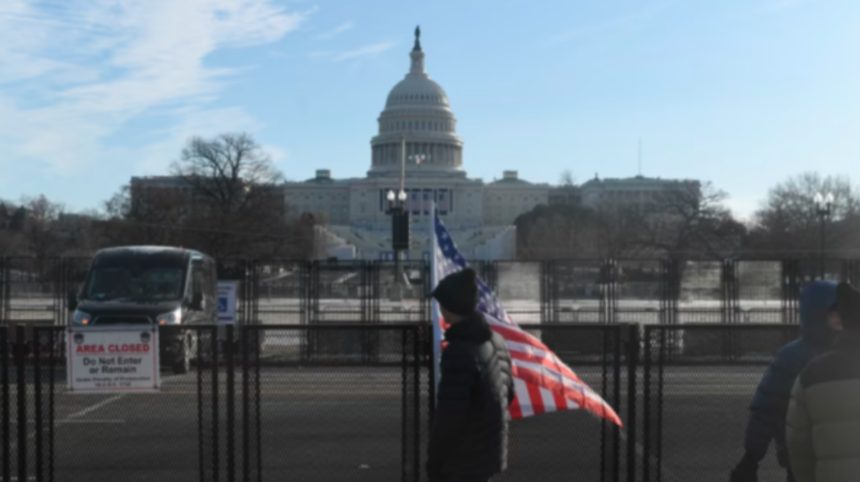Metal fences, concrete barriers, and security checkpoints continue to line the sidewalks and streets of the U.S. capital—from the Capitol to all key buildings— as the city prepares for the inauguration of the 47th president.
While this area, spanning 0.6 square kilometers, is usually a major attraction for tourists visiting the capital, this time it is not the focal point of security forces’ attention as the elected President is set to take the oath for the second time.
The extremely low temperatures on Monday prompted the elected president to decide to hold the ceremonies indoors. The inauguration will take place inside the Capitol building, and the traditional parade will be held at the “Capital One Arena,” a sports and concert hall nearby.
The change was announced on Friday, forcing security officials to adjust their plans at the last minute. There are many challenges for the 25,000 law enforcement officers and military personnel deployed in the capital.
“We will move the units,” said Matt McCool from the U.S. Secret Service during a briefing on Sunday. “We have not cut any part of the initial plan,” he added. “I am confident, with our partners here, that we will be ready.”
The number of visitors to Washington could make the situation particularly challenging.
Organizers had expected about 250,000 invitees, who had purchased tickets to attend the event at the Capitol. Now, only a select group will be allowed inside the ceremony at the Capitol rotunda, where only around 600 people can attend. The “Capital One Arena” has only about 20,000 seats.
Challenges could also arise if some of the 250,000 individuals planning to attend the inauguration tried to make their way to the “Capital One Arena.”
Washington Metropolitan Police Chief Pamela Smith said on Sunday that the police force had been reinforced with around 4,000 officers from across the country.
“Nothing has really changed,” Smith told reporters. “The movements of officers will be adjusted… So, we will still have officers stationed at locations throughout the city, as initially planned.”
Some officers, said Smith, will be positioned along the originally designated parade route, as people might try to gather to watch the presidential motorcade pass by.
The Capitol Police have also planned to position officers around the perimeter of the Capitol complex, even though the ceremony has been moved indoors.
The entire security contingent for the inauguration, made up of Secret Service agents, FBI agents, Capitol Police, and Metropolitan Police, will be directed by a command center, linked to a vast network of cameras across the capital.
Although some of the initial security measures have been eased in certain areas, officials stated that warnings will continue for visitors, indicating that this will not be a normal situation in Washington.
“They will see tactical units,” said McCool during a press briefing. “They will see officers and agents on rooftops, they will see checkpoints. They will see road closures and concrete barriers.”
Even before the inauguration was moved indoors, officials had prepared for what they describe as “a high-risk environment,” warning that the security plans for this inauguration are stronger than in the past.
Capitol Police Chief Tom Manger said that the biggest risk to everyone remains the possibility of an attack by a lone actor. “This risk… continues to be the primary reason we’re in a heightened state of readiness.”
These concerns were heightened following the New Year’s Day terrorist attack, where a car was used to strike pedestrians in New Orleans, and an explosion occurred in Las Vegas near the Trump International Hotel.
Earlier this month, Capitol Police arrested two individuals who were reportedly trying to disrupt the funeral ceremony for former President Jimmy Carter. One of them attempted to bring a knife and a machete into the Capitol, while the other set his car on fire.
Concerns were confirmed by a recent study from the Project on Security and Threats at the University of Chicago.
“Over 5% of Americans support using force to prevent Donald Trump from becoming president,” Robert Pape, the project leader, told Voice of America. “That’s about 14 million Americans,” he said. “This is unfortunately a concerning figure.”
President-elect Trump has already faced two assassination attempts.
The threat from Iran continues as well. Despite persistent denials from Iranian officials, American security officials have accused Tehran of attempting to assassinate President-elect Trump. Such a plot was revealed to have been planned for the days following the U.S. election.
For now, however, U.S. officials do not see any signs of immediate threats.
“The FBI is not currently tracking any credible or specific threats to the inauguration ceremony or the Capitol complex,” said the FBI’s Washington division in a statement to Voice of America. “We will continue to work closely with our partners to share information and identify and prevent any potential threats that may arise.”
Another source of concern is the tens of thousands of potential protesters, although there have been no major incidents so far.
The “People’s March” on Saturday, which was allowed to have up to 50,000 protesters, caused only brief tensions with supporters of President-elect Trump.
Another group, called “We Fight Back,” has been granted permission to hold protests on Monday, involving around 10,000 people in various locations.
“Please be aware that we will ensure your right to protest and assemble peacefully,” said Smith of the Metropolitan Police Department.
“However, I want to emphasize, as I always have, that violence, destruction, and illegal behavior will not be tolerated,” she said. “Violators will face swift and decisive consequences… we will be prepared to confront anyone who thinks they can enter this city to destroy property.”
*Kim Lewis contributed to this article. /VOA







